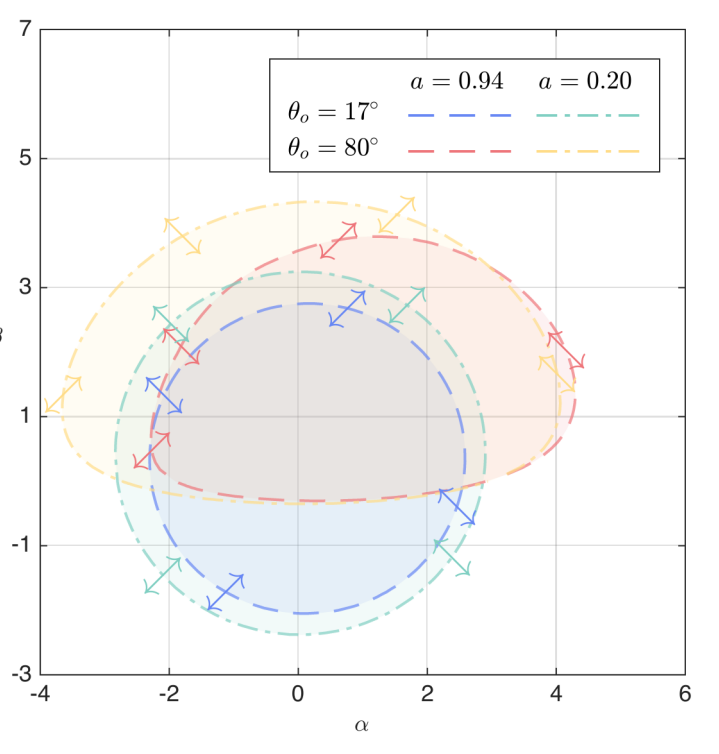The synchrotron emission from the accretion flow near the rotating black hole holds promise for accurately probing the spacetime geometry.
Rotating black holes dramatically distort the surrounding spacetime, compelling nearby matter to co-rotate through a process known as frame dragging. Radiation emitted from this matter can carry crucial signatures of the black hole’s intrinsic properties—especially its spin—making it a powerful probe for understanding these enigmatic objects. Recently, researchers from the Tsung-Dao Lee Institute at Shanghai Jiao Tong University, in collaboration with Peking University, Beijing Normal University, and Ningbo University, have conducted an in-depth investigation into this frontier topic. Through detailed theoretical modeling and calculations, the team discovered that synchrotron radiation emitted in the vicinity of the event horizon exhibits polarization patterns that are almost entirely governed by the black hole’s spacetime geometry, largely independent of the dynamics of the surrounding plasma. This breakthrough provides a novel and robust diagnostic tool for probing black hole properties, offering particularly promising prospects for precise measurements of black hole spin. The study not only advances our understanding of electromagnetic radiation mechanisms in extreme gravitational environments, but also lays a theoretical foundation for future black hole imaging efforts based on polarization observations. These findings were published recently in the prestigious journal “The Astrophysical Journal Letters.”
With the Event Horizon Telescope (EHT) having successfully captured the shadow images of M87* and the Milky Way’s central black hole Sgr A* in recent years, astronomers have, for the first time, “seen” black holes and begun probing the dynamics of surrounding plasma and the structure of spacetime in their immediate vicinity. Among the most powerful tools in this endeavour is polarization observation, which provides critical insights into the magnetic fields and accretion processes near black holes. Typically, the polarization patterns of synchrotron radiation emitted by magnetized plasma in strong gravitational fields are shaped by a complex interplay of magnetic field configurations, plasma dynamics, and gravitational lensing. As a result, polarization images encode both the physics of magnetized fluids and the geometry of curved spacetime. However, disentangling the pure gravitational signatures from this mixture has long posed a major challenge for both theory and observation. Bridging the gap from merely “seeing” black holes to truly “decoding” them requires the identification of new, stable observables that directly reflect the fundamental properties of black holes.
In this study, the research team found that near the event horizon of a rotating black hole, the intense frame-dragging effect induced by strong gravity twists the magnetic field and plasma into a tightly wound helical structure. This, in turn, imprints a distinct and stable polarization pattern in the observed image. Crucially, the resulting “near-horizon polarization” exhibits a high degree of universality: under certain idealized conditions, its morphology is determined primarily by the black hole’s spacetime geometry and is largely insensitive to the detailed motion of the plasma. This implies that the polarization image encodes “fingerprint-like” structural information about the black hole itself, offering a novel observable for diagnosing key parameters such as black hole spin.
The researchers further generalized the near-horizon polarization formula to a broader class of black hole solutions, demonstrating the wide applicability of this polarization structure. These findings suggest that near-horizon polarization patterns could serve as a powerful observational tool for testing general relativity and probing the spacetime geometry of black holes in future high-resolution polarimetric observations.

Figure 1: The polarization distribution along the edge of the event horizon on the image plane

Figure 2: (Left) Variation of the leading-order near-horizon net polarization direction along the horizon boundary for different black hole spins and viewing inclinations. (Right) Dependence of the leading-order near-horizon net polarization direction on black hole spin from a polar viewing angle.
The research not only provides a solid theoretical foundation for future high-precision black hole imaging and spin measurements but also opens a new avenue for testing the validity of general relativity in the strong-field regime through polarization observations. As next-generation EHT observation campaigns continue to advance, these findings are expected to be tested against real observational data, potentially driving significant progress in our understanding of black hole physics and the fundamentals of gravitational theory.
Publication:
Yehui Hou, Jiewei Huang, Minyong Guo, Yosuke Mizuno, Bin Chen
“Near-Horizon Polarization as a Diagnostic of Black Hole Spacetime”, The Astrophysical Journal Letters, 988, L51
doi: 10.3847/2041-8213/adee09
Contact Information:
Dr. Yehui Hou
Tsung-Dao Lee Institute, SJTU
houyh20061010@sina.com , yehuihou@pku.edu.cn
Mr. Jiewei Huang
School of Physics, PKU
Prof. Minyong Guo
School of Physics and Astronomy, BNU
Prof. Yosuke Mizuno
Tsung-Dao Lee Institute, SJTU
Prof. Bin Chen
Institute of Fundamental Physics and Quantum Technology, NBU

